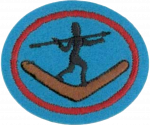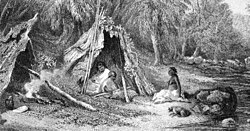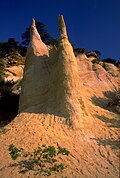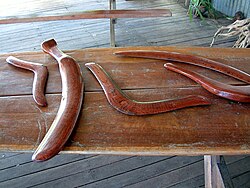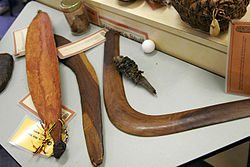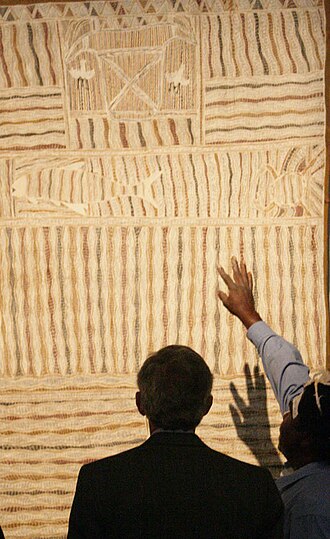Difference between revisions of "AY Honors/Aboriginal Lore/Answer Key/es"
(Created page with "{{clear}}") |
(Created page with "{{clear}}") |
||
| Line 223: | Line 223: | ||
{{clear}} | {{clear}} | ||
| − | + | {{clear}} | |
{{clear}} | {{clear}} | ||
| − | |||
{{clear}} | {{clear}} | ||
| − | + | {{clear}} | |
| − | |||
| − | |||
| − | + | {{clear}} | |
| − | |||
| − | |||
| − | + | {{clear}} | |
| − | |||
{{clear}} | {{clear}} | ||
| Line 247: | Line 241: | ||
In 1770, Lieutenant James Cook claimed the east coast of Australia in the name of Great Britain and named it New South Wales. British colonisation of Australia began in Sydney in 1788. The most immediate consequence of British settlement – within weeks of the first colonists' arrival – was a wave of European epidemic diseases such as chickenpox, smallpox, influenza and measles, which spread in advance of the frontier of settlement. The worst-hit communities were the ones with the greatest population densities, where disease could spread more readily. In the arid centre of the continent, where small communities were spread over a vast area, the population decline was less marked. | In 1770, Lieutenant James Cook claimed the east coast of Australia in the name of Great Britain and named it New South Wales. British colonisation of Australia began in Sydney in 1788. The most immediate consequence of British settlement – within weeks of the first colonists' arrival – was a wave of European epidemic diseases such as chickenpox, smallpox, influenza and measles, which spread in advance of the frontier of settlement. The worst-hit communities were the ones with the greatest population densities, where disease could spread more readily. In the arid centre of the continent, where small communities were spread over a vast area, the population decline was less marked. | ||
| − | + | {{clear}} | |
| − | + | {{clear}} | |
{{clear}} | {{clear}} | ||
Revision as of 21:19, 1 December 2014
| Folclore de Aborígenes Australianos | ||
|---|---|---|
| División del Pacífico Sur
|
Destreza: 1 Año de introducción: Desconocido |
|
Requisitos
1. ¿Quiénes son los aborígenes y de dónde han venido? ¿Cuántas tribus había allí cuando comenzó la colonización europea?
2. Discuss the tribal system. What are totems?
Australian Aboriginal kinship is the system of law governing social interaction, particularly marriage, in traditional Aboriginal culture. It is an integral part of the culture of every Aboriginal group across Australia.
Each skin group has certain totems associated with it. Some Aboriginal groups, such as the Yolngu, include plants, animals and all aspects of the environment, as part of their respective skin groups.
A person of the same skin group, of the same generation, is called "brother" or "sister". There are names for maternal aunts and uncles and different names for paternal aunts and uncles. Additionally, there are strong avoidance relationships that need to be observed based on this system.
3. Discuss the food of the Aborigines:
a. Kinds
Indigenous Australian peoples traditionally classified food sources in a methodical way. Various groups categorized them differently, so it is not possible to present a definitive list of food types, so we present an example here.
In Central Australia, people used innovative means to obtain a balanced diet.
Arrernte name Foods Examples Kere food from animals; meat, fat, offal, blood, eggs Kere arlewatyerre (goanna), Kere ulkerte (perentie), Kere arntetherrke (carpet snake), Kere aherre (kangaroo), Kere antenhe (possum), Kere inape (porcupine (echidna), Kere ankerre (emu). Merne food from plants; fruit, vegetables Merne atwakeye (wild orange), Merne arrutnenge (wild passionfruit), Merne pmerlpe (quandong), Merne mwanyeme (bush tomato), Merne arnweketye (conkerberry), Merne alangkwe (bush banana), Merne arlatyeye (pencil yam). Ntange (Merne ntange) edible seeds Merne ntange ulyawe (Pigweed seed), Merne ntange arlepe (Prickly wattle seed), Merne ntange artetye (Mulga seed), Merne ntange arlketyerre (Dead finish seed). Tyape edible grubs and insects; witchetty grub, cicadas, Tyape atnyematye (Witchetty grub), Tyape ahernenge (River red gum grub), Tyape ankerrutne (Coolibah tree grub), Tyape tyerraye (Cicadas), Tyape ayepe-arenye (Tar vine caterpillars). Ngkwarle (Australian Aboriginal sweet foods) honey-like foods; nectar, wild honey, lerps, gum Ngkwarle athenge arlperle (Ironwood tree gum), Ngkwarle alkerampwe (Mulga tree gum, Ngkwarle arlperrampwe (Whitewood tree gum, Ngkwarle atnyerampwe (Supplejack tree gum), Ngkwarle akikarre (Witchetty bush gum), Ngkwarle aperarnte (River Red gum honeydew, Ngkwarle yerrampe, (Honeyant), Ngkwarle arwengalkere (Native bee honey), Ngkwarle untyeyampe (Corkwood flower nectar).
b. How obtained
Witchetty Grub
The Witchetty grub was a staple among women and children. It was obtained thusly:
- Find cracks in the ground underneath a Witchetty bush (Acacia kempeana)and dig there
- Lever up swollen root where the grubs are located
- Eat grubs raw or cooked in hot earth
Collecting Seeds
Seeds varied depending on the time of year and the area in Australia that the people lived. In Central Australia, native millet (Panicum decompositum; Panicum australianse) and spinifex were commonly used. Wattleseed could also be used in the flour mix.
Women harvested the fully ripe, dry seeds of the plant by beating the grass (or pod-laden trees with sticks in the case of wattleseed) to dislodge the seeds. Some species were eaten at the green stage and, when ground, would produce a juice at the side of the millstone, which was drunk directly.
c. How prepared
Various traditional methods of processing and cooking are used. Toxic seeds, such as Cycas media and Moreton Bay chestnut are processed to remove the toxins and render them safe to eat. Many foods are also baked in the hot campfire coals, or baked for several hours in ground ovens. ‘Paperbark’, the bark of Melaleuca species, is widely used for wrapping food placed in ground ovens. Bush bread was made by women using many types of seeds, nuts and corns to process a flour or dough to make bread.
After the grain was collected, it needed to be winnowed, which was done using the coolamon, the multi-purpose carrying vessel. Sometimes it needed to be winnowed several times.
Once the grain was winnowed, it was ground using a millstone, to create flour. The flour was then mixed with water to make a dough and placed in hot ashes for baking. The results could be small buns, today referred to as johnny cakes, or a large loaf, known today as damper. Damper appears to be a mix of this traditional style of bread-making and European-style bread-making.
The dough could also be eaten raw. Cooking was a good way to prepare the bread if the group was about to travel for some time.
4. Discuss their homes. Of what are they made and why are they not permanent? Where do the young men and boys sleep?
A humpy is a small, temporary shelter made from bark and tree branches, traditionally used by Australian Aborigines, with a standing tree usually used as the main support. The word humpy comes from the Jagara language (a Murri people from Coorparoo in Brisbane); other language groups would have different names for the structure.
The word humpy was adopted by early white settlers, and now forms part of the Australian lexicon. Small impermanent dwellings, made of branches and bark (particularly paperbark) were built prior to the construction of more permanent buildings, and were referred to as humpies.
In South Australia, such a shelter is known as a "wurley" (also spelled "wurlie"), possibly from the Kaurna language. The name "gunya" is also used.
The Aborigines were a nomadic people, moving from place to place as the foods upon which they depended came into and went out of season. They did not typically stay in a given vicinity for a long period of time, and thus, it was not their habit to create permanent structures.
Young boys and men slept near the fire at night, while the young girls slept inside with their mothers.
5. How do they communicate with other tribes who may not understand their language? How do they send signals within the tribe? What is the purpose of the Tjuringa (or Churinga)?
Communication with other tribes
A message stick is a form of communication traditionally used by the Aborigines. It is usually a solid piece of wood, around 20–30cm in length, etched with angular lines and dots.
Traditionally, message sticks were passed between different clans and language groups to establish information and transmit messages. They were often used to invite neighbouring groups to corroborees, set-fights and ball games.
Alfred Howitt wrote of the Wurundjeri people of the Melbourne area:
- The oldest man (Headman) having made such a message stick hands it to the old man nearest to him, who inspects it and, if necessary, adds further marks and gives corresponding instructions. Finally, the stick having passed from one to the other of the old men present is handed to the messenger, who has received his verbal message in connection with it.
They are often commonly called letters by Aboriginal people. They were transmitted by mailmen, who could travel hundreds of kilometres to deliver them.
Signals within the tribe
Many Australian Aboriginal cultures have or traditionally had a sign language counterpart to their spoken language. This appears to be connected with various taboos on speech between certain people within the community or at particular times, such as during a mourning period for women or during initiation ceremonies for men – unlike indigenous sign languages elsewhere which have been used as a lingua franca (Plains Indian Sign Language), or due to a high incidence of hereditary deafness in the community (Yucatec Maya Sign Language, Adamorobe Sign Language and Kata Kolok).
Sign languages appear to be most developed in areas with the most extensive speech taboos: the central desert (particularly among the Warlpiri and Warumungu), and western Cape York.[1] Complex gestural systems have also been reported in the southern, central, and western desert regions, the Gulf of Carpentaria (including north-east Arnhem Land and the Tiwi Islands), some Torres Strait Islands, and the southern regions of the Fitzmaurice and Kimberley areas. Evidence for sign languages elsewhere is slim, although they have been noted as far south as the south coast (Jaralde Sign Language) and there are even some accounts from the first few years of the 20th century of the use of signs by people from the south west coast. However, many of these sign languages are now extinct, and very few accounts have recorded any detail.
Tjuringa
A Tjuringa is an object of religious significance by Central Australian Indigenous Australian people of the Arrernte (Aranda, Arunta) groups. Tjuringa often had a wide and indeterminate native significance, they included: Sacred ceremonies, Stone Objects, Wooden sacred objects, Bullroarers, Sacred ground paintings, Ceremonial poles, Ceremonial head gear, Sacred chants, Sacred earth mounds.
Generally speaking, tjuringa denote sacred stone or wooden objects possessed by private or group owners together with the legends, chants, and ceremonies associated with them. They were present among the Arunta, the Loritja, the Kaitish, the Unmatjera, and the Illpirra. These items are generally oblong pieces of polished stone or wood. Some of these items have hair or string strung through it and were named “bull roarers" by Europeans. Upon each tjuruiga is a totem of the group to which it belongs. Tjuringa are highly sacred, in fact, they are considered so sacred that only a few were able to see them and likewise it is considered sacrilegious to post a picture of them.
6. What are some of the articles of trade and exchange? What domestic utensils do they use.
Articles of Trade
Domestic Utensils
These are a few of the utensils used by the Aborigines.
- Carrying bags
- Made from kangaroo hides, woven fibers, or bowls carved from wood, these items were used for carrying all sorts of items.
- Digging Sticks
- Short, sharpened sticks, hardened at the tip by fire. Used for many purposes, including digging up tubers.
- Fire Starters
- Friction made by a stick twirled between the hands would light tinder and start a fire.
- Grinding Stones
- used for grinding seeds into flour.
- Knife
- Knives were made from stone or bone.
- Thardo
- A utensil used for separating grain from chaff.
7. Describe some of the weapons used in hunting and warfare.
Boomerang and Throwing Sticks
Boomerangs are curved pieces of wood used as weapons and sport equipment. Boomerangs come in many shapes and sizes depending on their geographic or tribal origins and intended function. The most recognisable type is the returning boomerang, which is a throwing stick that travels in a elliptical path and returns to its point of origin when thrown correctly. Although non-returning boomerangs (throw sticks or kylie's) were used as weapons, returning boomerangs have only ever been used for leisure or recreation.
No one knows for sure how the returning boomerang was first invented, but some modern boomerang makers speculate that it developed from the flattened throwing stick, still used by the Australian Aborigines and some other tribal people around the world. A hunting boomerang is delicately balanced and much harder to make than a returning one. Probably, the curving flight characteristic of returning boomerangs was first noticed by stone age hunters trying to "tune" their hunting sticks to fly straight.
Boomerangs (termed "throwsticks") for hunting larger prey, such as kangaroo, were used for small prey as well. These throwsticks fly in a nearly straight path when thrown horizontally and are heavy enough to take down a kangaroo on impact to the legs or knees. For hunting emu, the throwstick is thrown toward the neck, breaking it.
Woomera
A woomera is an Australian Aboriginal spear-throwing device usually used for larger prey or when there is a greater distance to be overcome. It has been described as "the most efficient spear-throwing device ever". Similar to an atlatl, it enables a spear to travel much further than by arm strength alone. It is very much like an extension of the arm, enabling the spear to travel at a greater speed and force than what would normally be attainable unaided. It is still used today in some remote areas of Australia.
As with spears and boomerangs, woomera were traditionally only used by men. Some woomeras, especially those used in the Central and Western Australian deserts, were multi-purpose tools. Often shaped like long narrow bowls, they could be used for carrying water-soaked vegetable matter (which could later be sucked for its moisture, but wouldn't spill) as well as small food items such as little lizards or seeds. Many woomeras had a sharp stone cutting edge attached to the end of the handle with black gum from the spinifex plant. This sharp tool had many uses – and was commonly used for cutting up game or other food, cutting wood, and so on.
The woomera could be used as a shield for protection against spears and boomerangs. Some boomerangs were deliberately made with a hook at one end designed to catch onto the edge of a woomera or shield, which then caused the boomerang to swivel around and hit the enemy.
The woomera was traditionally decorated with incised or painted designs which gave a good indication of the owner's tribal or clan group, giving one their sense of identity or "being".
They were made by both men and women and could be painted or left unpainted. Their construction varied from tribe to tribe, but they were generally about one metre in length and sometimes had a stone head attached with bees wax and string. They were made from where a branch met the tree, or from a young tree pulled up with its roots from the ground.
Originally, the word waddy referred to a tree, or any piece of wood, as well as a verb meaning to 'beat up or kill with a club'.
8. What is a corroboree? Explain its purpose. What are clap sticks and the didgeridoo?
Corroboree
A corroboree is a ceremonial meeting of Australian Aborigines. The word was coined by the European settlers of Australia in imitation of the Aboriginal word caribberie. At a corroboree Aborigines interact with the Dreamtime through dance, music and costume. Many ceremonies act out events from the Dreamtime. Many of the ceremonies are sacred and people from outside a community are not permitted to participate or watch.
In the northwest of Australia, corroboree is a generic word to define theatrical practices as different from ceremony. Whether it be public or private, ceremony is for invited guests. There are other generic words to describe traditional public performances: juju and kobbakobba for example. In the Pilbara, corroborees are yanda or jalarra. Across the Kimberley the word junba is often used to refer to a range of traditional performances and ceremionies.
Corroboree is a generic word to explain different genres of performance which in the northwest of Australia include balga, wangga, lirrga, junba, ilma and many more. Throughout Australia the word corroboree embraces songs, dances, rallies and meetings of various kinds. In the past a corroboree has been inclusive of sporting events and other forms of skill display. It is an appropriated English word that has been reappropriated to explain a practice that is different to ceremony and more widely inclusive than theatre or opera.
Clap sticks and the didgeridoo
Aboriginal people developed unique instruments and folk styles. The didgeridoo is commonly considered the national instrument of Aboriginal people, and it is claimed to be the world's oldest wind instrument. However, it was traditionally only played by Arnhem Land people, such as the Yolngu, and then only by the men. It has possibly been used by the people of the Kakadu region for 1500 years. Clap sticks are probably the more ubiquitous musical instrument, especially because they help maintain the rhythm for the song.
9. What games do children play? How are young men trained? How are they initiated? What is the bora ground? What is a bull roarer?
Games
Marn Grook (also spelt marngrook), literally meaning "Game ball", is the collective name given to a number of traditional Indigenous Australian ball games believed to have been played at gatherings and celebrations of up to 50 players.
The earliest accounts, mostly from the colonial Victorian explorers and settlers, date back to just prior to the Victorian gold rush in the mid 1800s, but the game is suspected to have been played for many thousands of years. This connection justifies the claim of Australian Rules Football as being one of the oldest games still played today, albeit changed.
Marn Grook is especially notable as it is claimed by some to have had an influence on the modern game of Australian rules football, most notably in the catching of the kicked ball (the mark in Australian football) and, in particular, high jumping (the spectacular mark in Australian football) exhibited by the players of both games.
The 1858 Australian Rules game between Scotch College and Melbourne Grammar School, which is believed by most historians to have been the first Australian Rules game, included a number of the features of Marn Grook; in particular, the large number of players and the large area of play (the 1858 game had goals that were 500 metres apart). Both of these features disappeared from Australian Rules after the first rules were drawn up in 1859.
10. Discuss the two main types of Aboriginal art.
There are many "types" of Aboriginal art, but the two most famous types appear to be bark painting and rock art.
Bark Painting
Bark painting is an Australian Aboriginal art-form which is done on the interior strip of a tree bark. Traditionally, bark paintings were produced for instructional and ceremonial purposes and were transient objects. Today, they are keenly sought after by collectors and public arts institutions.
11. Briefly relate the history of the Aborigines since the white man arrived in Australia, mentioning the government policies through the years and the work of missions.
1788-1900
In 1770, Lieutenant James Cook claimed the east coast of Australia in the name of Great Britain and named it New South Wales. British colonisation of Australia began in Sydney in 1788. The most immediate consequence of British settlement – within weeks of the first colonists' arrival – was a wave of European epidemic diseases such as chickenpox, smallpox, influenza and measles, which spread in advance of the frontier of settlement. The worst-hit communities were the ones with the greatest population densities, where disease could spread more readily. In the arid centre of the continent, where small communities were spread over a vast area, the population decline was less marked.
Referencias
- Categoría: Tiene imagen de insignia
- Adventist Youth Honors Answer Book/Honors/es
- Adventist Youth Honors Answer Book/es
- Adventist Youth Honors Answer Book/Skill Level 1/es
- Categoría: Libro de respuestas de especialidades JA/Especialidades introducidas en Desconocido
- Adventist Youth Honors Answer Book/South Pacific Division/es
- Adventist Youth Honors Answer Book/Unknown/es
- Adventist Youth Honors Answer Book/Unknown/Primary/es
- Adventist Youth Honors Answer Book/Stage 100/es
- Adventist Youth Honors Answer Book/Completed Honors
